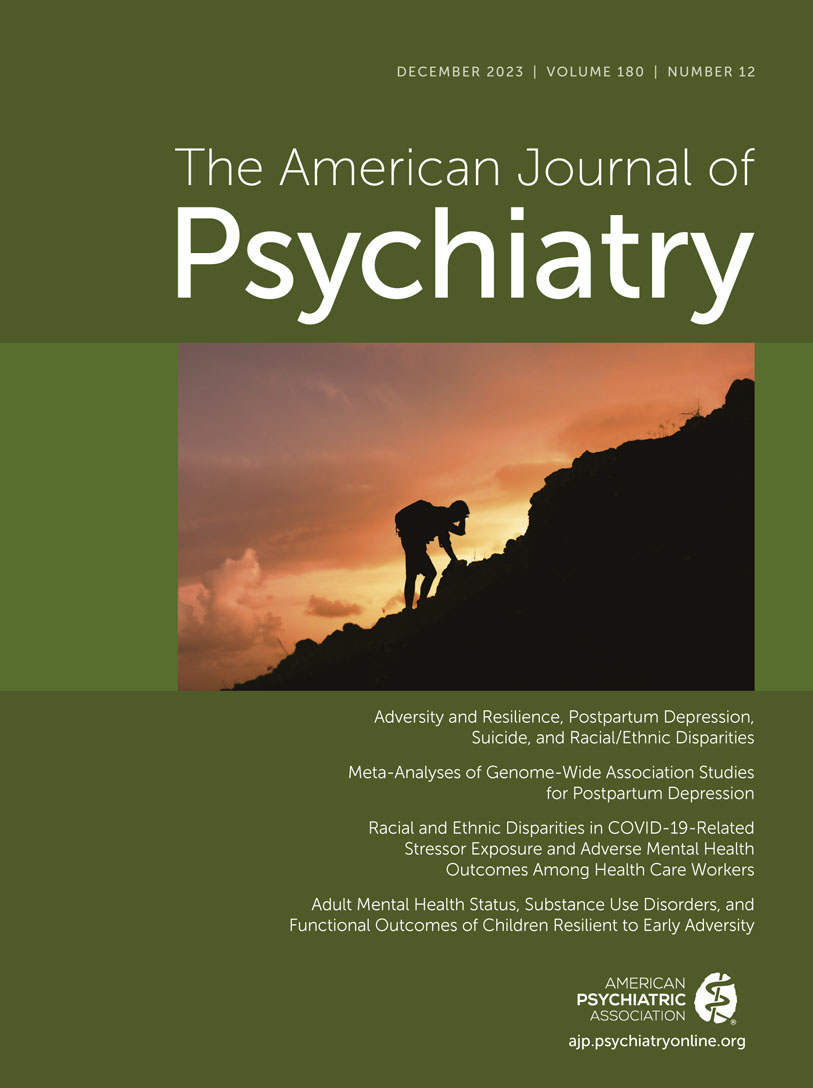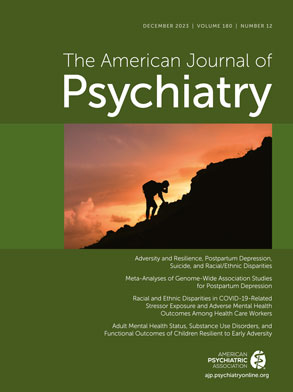The study by Breslow et al. (
1) in this issue explores racial and ethnic disparities in exposure to COVID-19 stressors and adverse mental health outcomes among health care workers. The investigators surveyed health care workers across many roles, ranging from physicians and nurses to researchers to administrative and support staff, within the Montefiore Health System. Montefiore is the largest health care network in the Bronx. The Bronx has the highest rates of poverty and levels of exposure to environmental stressors in New York City (
2). Bronx residents had the highest per capita rates of COVID-19 infection, hospitalization, and mortality in New York City.
Breslow et al. found that Latinx, Black, Asian, and multiracial/other health care workers, compared with their White colleagues, reported significantly higher exposure to multiple types of COVID-19-related stressors: redeployment, fear of being sick, lack of autonomy at work, and inadequate access to personal protective equipment. Interestingly, although the extent of exposure was generally related to pandemic-related distress across all groups, it was not equally associated with adverse mental health outcomes or hazardous alcohol use across groups. Latinx individuals showed greater levels of anxiety and posttraumatic stress symptoms relative to their level of exposure to stressors. White individuals reported disproportionally more hazardous alcohol use than any other group and significantly more anxiety than Asian individuals. Black and Asian health care workers showed higher levels of exposure but relatively lower adverse mental health outcomes than their White colleagues.
The authors concluded that the increased exposure to COVID-related stressors is a result of structural racism.
It is of paramount importance to conduct this kind of research because structural racism affects numerous areas of health care (
3). But it is equally important to define the assumptions and evaluate the methodological choices that are made when constructing, analyzing, and interpreting such findings. Such clarity ensures that the conclusions drawn about structural racism are grounded in a theoretical framework (
4) that can offer structural interventions to relevant stakeholders. Structural racism was not defined in the article, but the term deserves explication in the context of the disparities noted.
We previously defined structural racism as macro-level societal conditions that limit the opportunities, resources, and well-being of less privileged groups on the basis of race/ethnicity and other factors (
5). Breslow et al. inferred that the cumulative endorsement of exposure to COVID-19 stressors suggested structural racism. But this inference assumes that the types of exposure that were assessed reflected issues that were salient to persons of color; furthermore, it assumes that respondents were represented equitably with respect to race and ethnicity and in a manner that might reflect racial and ethnic differences within different health care categories.
The authors noted that Montefiore has a racially and ethnically diverse workforce, with a distribution of race/ethnicity among health care workers that is 33.74% Black, 25.89% White, 23.04% Latinx, 15.20% Asian, and 2.13% multiracial/other. In contrast, the distribution of race/ethnicity in the study sample was 51.9% White, 10.6% Black/African American, 14.3% Latinx/Hispanic, 16.5% Asian/Asian American, and 6.7% multi/biracial or other. Data were not provided regarding group differences within different categories of health care workers on variables such as income or whether respondents resided in the Bronx. These questions would have provided a greater interpretative context for the results.
The response rate in this study reflects a well-known trend for people of color to be underrepresented in research. This is an exigent problem because it is difficult to learn about racial differences from surveys if mostly White people respond. It is therefore important to consider how to increase representation of people of color more generally, but particularly in studies designed to assess structural racism. The key may be in identifying questions that address the unique needs and concerns of people of color.
One of the most powerful ways of conducting research examining potential racial bias is to include representation from communities of color in the process of study conception. This can be accomplished by employing principles of community-engaged research (
6), an empirically supported, equitable approach to study design and implementation that centers the voices of persons of color (
7). If members of the communities are thus engaged, they can offer key insights about how to frame questions of greatest relevance, and they can advise on recruitment strategies that would maximize participation.
The use of community-engaged research methods in this study would have helped to contextualize the study period of April 4, 2020, through January 26, 2021. As the authors note, the United States also saw increased attention to racial injustice during this period of the pandemic, largely in response to the murder of George Floyd (
8). However, the survey did not include questions that might engage persons of color and White individuals by considering the impact of these events on mental health symptoms.
Should it have? Perhaps, perhaps not. If such questions had been asked, the focus might have been shifted away from exposure-based inequities in the health care workforce. These inequities were what the researchers sought to examine. Conducting a survey geared toward understanding what people of color were experiencing during the COVID-19 pandemic without considering such sources of racial bias may have resulted in a disengaged pool of potential respondents who may not have felt that the research was relevant to their needs or concerns. This methodological dilemma raises the question of whether the assumption that the same question can be used universally to adequately detect racial and ethnic differences is in itself a form of bias. There is no simple answer here, but more diverse views would lead to greater consensus.
Many health care workers of color may not have felt safe in the Bronx during the COVID-19 pandemic, not only because of work-related stressors that they experienced but also because of feeling that their lives were at risk every day because they were persons of color in America. It is not clear whether important mental health outcomes related to issues of basic safety and security were captured in a survey restricted to questions about COVID-19-related stressors and outcomes. Had the study stated an intention to capture the impact of exposures related specifically to being a person of color and a health care worker during a global pandemic, the response rate among people of color might have been higher. An advisory board that included persons of color could have offered useful input into questions that would be relevant to people of color within a health care network during a pandemic.
Notably, Breslow et al. hypothesized that persons of color might show evidence of lower levels of mental health symptoms, despite having exposure to more of the stressors that were asked about. This hypothesis was based on previous findings showing a tendency for White individuals, compared with people of color, to report greater levels of depressive symptoms with less exposure to major life stressors, the so-called “depression paradox” (
9). This finding has previously been attributed to higher levels of distress tolerance and coping strategies among racial and ethnic groups, particularly Black and Asian individuals, despite or perhaps related to greater exposure to societal stressors (
10).
It is interesting to consider whether lower levels of distress, or higher ones for that matter, are influenced by race and ethnicity from the perspective of either biological risk factors or cultural ones. It is also important to consider the extent of systemic over- and underreporting based on race and ethnicity (
11). The issue of stress tolerance may certainly be confounded by racial and ethnic differences in what is perceived as stressful. Perhaps Asian and Black adults don’t have fewer adverse mental health outcomes but rather are less likely to report them. Alternatively, perhaps White and Latinx adults are more likely to endorse these symptoms, or, as suggested by Breslow et al., they are more susceptible to stress.
Even if it is assumed that the sample was representative and that the questions were equally salient in all the groups, it is difficult to unpack these issues without also considering the societal and community buffers that might help mitigate mental health consequences typically associated with acute or chronic distress. It is for this reason that the recommendation of increased need for services in the face of less adverse mental health outcomes is so interesting. If we take the respondents at their word, they have fewer symptoms and may be more resilient in one sense of that definition, even if exposed to a greater number of stressors. The findings raise the question of whether we learn more from quantifying exposure to stressors or from examining the impact of such events.
Hazardous alcohol use was associated with being White. It is poignant that in a paper designed to identify differential exposure and outcomes across racial and ethnic groups that White participants demonstrated greater susceptibility to stress. Is this because of poorer coping strategies or a lack of social support, religiosity, and community resources? These questions need to be asked, particularly if it is suspected that stressor exposure and outcomes vary by group. Surveys that query participants about exposure to stressors should include not only adverse outcomes but also coping strategies that might moderate the effects. The results could help determine whether resilience-associated strategies are employed differentially across racial and ethnic groups.
To us—a White psychologist, working and living in the Bronx during the pandemic, and a Black psychiatrist, working in Harlem—there was a palpable feeling during the pandemic of greater distress in communities of color, not only among health care workers of color but also among patients of color receiving primary, specialty, and mental health care in Bronx-based hospitals. But it was hard to disentangle COVID-19-related concerns with other issues of safety and security resulting from the killing of persons of color by law enforcement during this time. It is possible that the need to address racial injustice overshadowed the risk of COVID-19 exposure in New York City. Alternatively, people of color may have experienced increased social support from widespread community outrage and activism that contributed to positive mental health outcomes.
During the pandemic, there was greater exposure to stressors among people of color, whether or not they were health care workers. But there were also impressive signs of communal action, which may have served to combat helplessness and thus moderate anxiety and depression. We have much to learn by bringing persons of color to the table in the earliest stages of study design, throughout implementation of the research, interpretation of the data, and dissemination of findings, and while addressing the gaps identified by the findings. This approach will increase representation of people of color in studies, and therefore our confidence in research data that will allow us to build solutions for stakeholders and constituents.
We are in it together.

